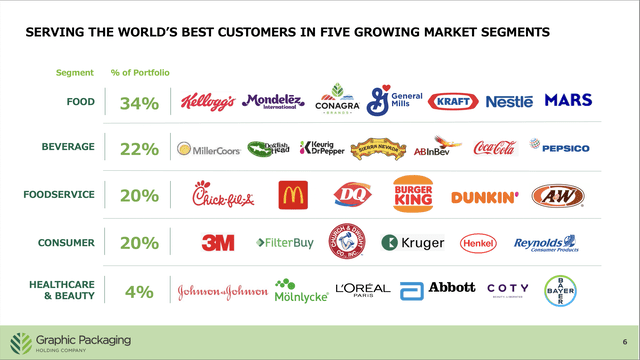Thesis
Graphic Packaging Holding (NYSE:GPK) is the #1 fiber-based consumer packaging company in Europe and the USA. Being a market leader, GPK is set to benefit from the growing demand for consumer packaging. The company’s portfolio of customers is well diversified across many different industries, and no customer makes up more than 5% of total revenue. In my opinion, the company is currently trading at an attractive valuation of 7.70x EV/EBITDA. I will explain each of my thesis’s key parts in the following sections.
Company Overview
GPK’s business model is very simple. They provide customers with paper-based packaging solutions for products such as food, beverage, and many more. 76% of revenue comes from the Americas, 22% from Europe, and 2% from the ROW. Business segment include Americas Paperboard Packaging, Paperboard Mills, Europe Paperboard Packaging, and Corporate/Other.
Outlook
GPK is what is called a company with pseudo-sticky revenue. This basically means that customers continuously pay for the product without it being directly related to a subscription. 76% of GPK’s customers provide products that are consumed on a daily basis. People will always consume McDonald’s, Chick-fil-A, Nestle, PepsiCo, and others. Long-term growth for these companies is mainly attributed to population growth. Which is expected to keep growing. So as people consume more food, drinks, and snacks, GPK will benefit by providing more packaging for those products. Most of GPK’s customers are dominant businesses underpinned by a wide economic moat, which means they are here to stay and aren’t going away anytime soon. This provides GPK with a steady revenue stream as long as the companies don’t deviate from their products. No customer makes up more than 5% of GPK’s sales.
Company’s Presentation
Fiber-based packaging is also expected to grow between 2 and 3% annually from 2023 to 2028. The firm has proven to do well during economic downturns. Revenue grew by 32% in 2022, despite all the talk about consumers spending less. The revenue growth was mainly attributed to the acquisition of AR Packaging (one of Europe’s leading companies in the packaging sector). The company can still expand globally since 24% of its revenue comes from outside of the Americas. GPK only operates in 17 other countries, excluding the Americas. This leaves the company with a lot of room for expansion.
Many countries are also pushing for a better environment, which translates into shifting away from non-recyclable packaging such as plastic and styrofoam and moving towards recyclable packaging. ~95% of GPK’s revenue is from technically recyclable products. Also, the company’s primary raw materials are renewable, such as fiber wood. Companies such as McDonald’s, Pepsi, Chick-fil-A, and more care about their reputations, and being partnered with a company where ~95% of its revenue comes from products that are practically recyclable is a good thing for the public’s eye.
Valuation
GPK is currently trading below its 5-year P/E and EV/EBITDA averages. My DCF valuation (base case) suggests a 39% upside from the current price of $24. My assumptions are that revenue will grow at an annual compounded growth rate of 3% from 2023 to 2027. For the 2023 revenue estimate, I used the company’s guidance of ~$10 billion because the firm seems to have a good track record (my estimate was $9.9 billion). The main revenue drivers in my model are industry and customer growth rates. I expect the company to generate $3 billion in free cash flow from 2023 to 2027. Using a discount rate of 6.35% to discount the future cash flows and terminal value, I arrived at an equity value of $10 billion, which translates into $32 per share. The low revenue growth is attributed to GPK’s industry. It doesn’t offer much organic growth. and the firm already has some of the biggest enterprises in its portfolio however, the company can acquire other firms to break into a new geographic area, as it did with AR packaging.
Risks
1) The company currently has $5.5 billion in debt. Long-term debt increased by ~$2.7 billion in 2022, mainly due to the financing needed for the acquisition of AR Packaging. I believe that debt isn’t a big risk for the company because, with an ~8% free cash flow yield, the firm would be able to keep up with its debt repayments.
2) Changes in customers’ buying habits can impact a company’s sales. These habits can be influenced by a bunch of factors, such as costs, convenience, and health considerations, as well as environmental and social concerns. GPK is addressing this problem by making sure they use recyclable materials in their products.
3) Increases in the prices of raw materials such as fiber, petroleum-based materials, energy, wood, and transportation can make it hard for the firm to raise prices or improve profitability. Paper manufacturing processes require significant energy and raw materials, the costs of which are subject to worldwide supply and demand factors and supply chain disruptions that can affect availability and result in increased prices.
Takeaway
The bottom line is that GPK is a leading consumer packaging company with a stable and sticky business model. Despite the economic downturn, the company still managed to grow in 2022. Free cash generation has allowed the company to not just pay down debt in 2022 but also repurchase stock. I expect the company to continue allocating a portion of its capital toward stock buybacks. As governments and corporations keep pushing away from unrecyclable materials such as plastic and styrofoam for a safer environment, GPK stock is set to benefit from this shift.
“I try to invest in businesses that are so wonderful that an idiot can run them. Because sooner or later, one will.” – Warren Buffet
Read the full article here












